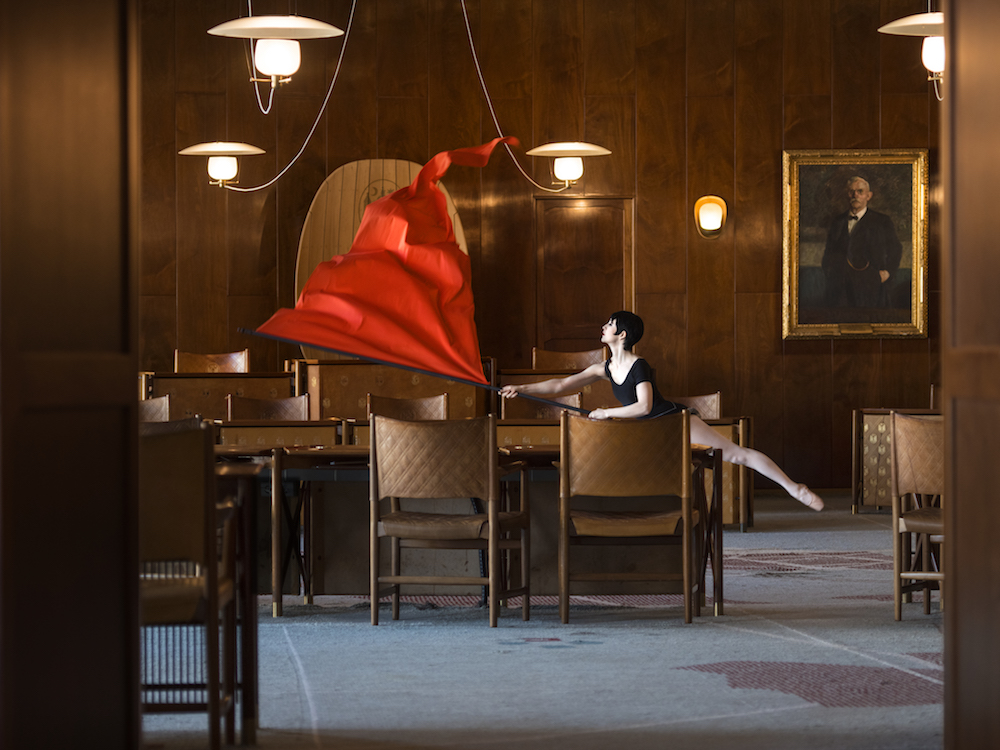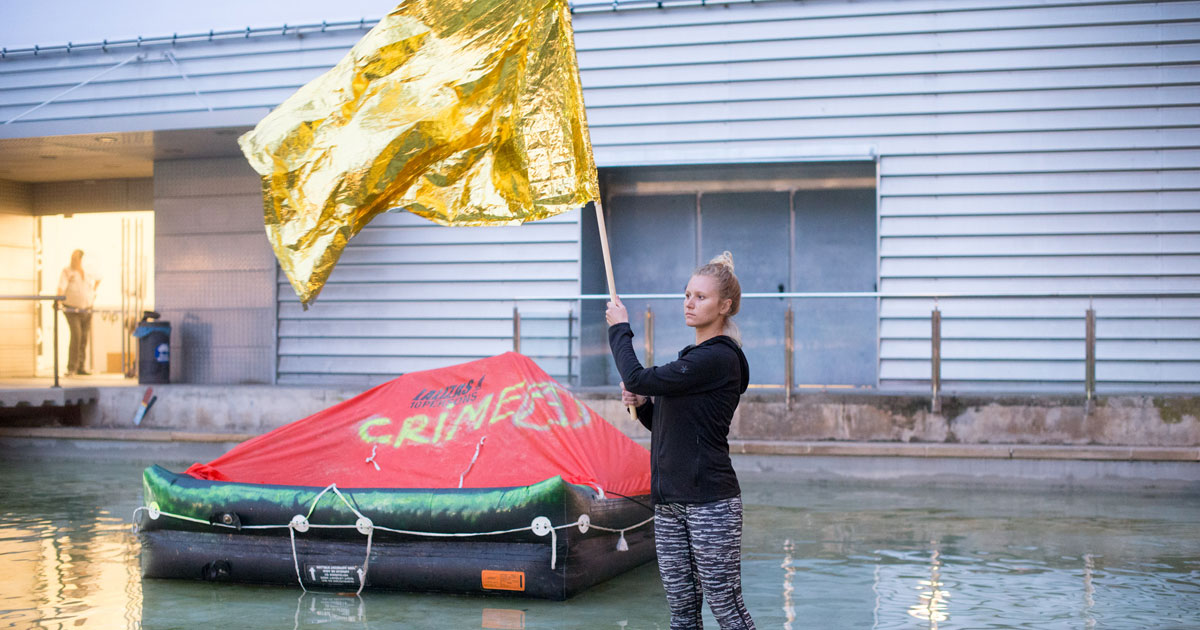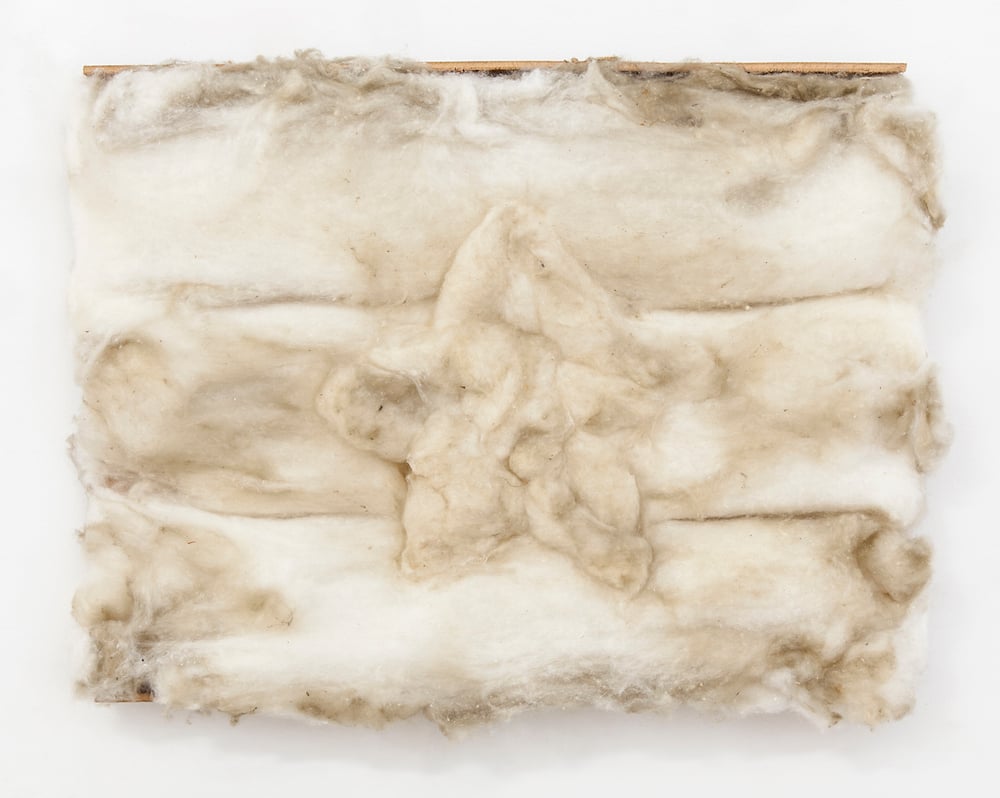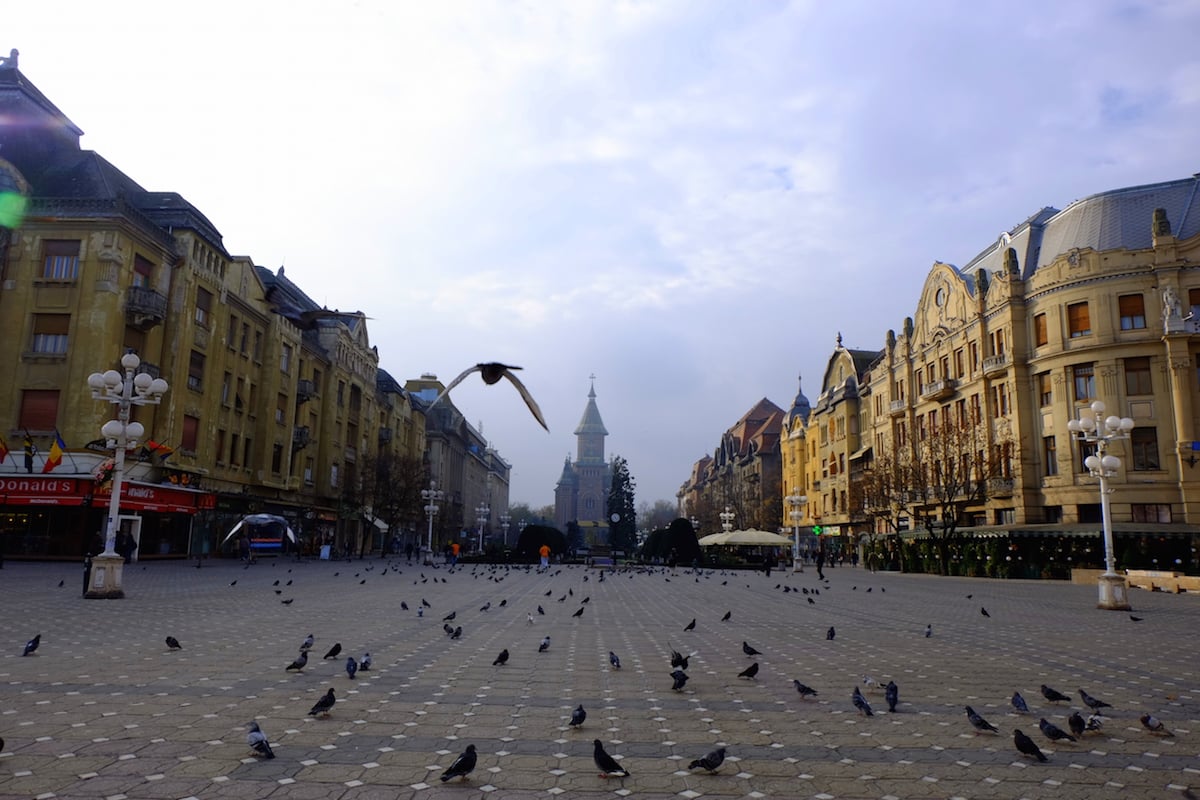Jasmina Cibic: the provocative Slovenian artist on staging her own propaganda spectacle

Jasmina Cibic’s projects are ambitious in scale and concept. Since representing Slovenia at the 55th Venice Biennale in 2013, she has taken to disentangling the alliances between art, architecture and politics. With her latest exhibition, The Machine Builds Nations, the artist builds her own propaganda machine
At the opening of Jasmina Cibic’s latest solo show, This Machine Builds Nations, at the BALTIC Centre for Contemporary Art in Gateshead, several women perched on ladders are painting words on wall panels. Their outfits, inspired by socialist utility clothing of the past, are the first clue that these are not gallery assistants putting the finishing touches to the exhibition. What they are painting, in fact, are slogans collected from political speeches. What I’m looking at appears less like a gallery install and more like the preparation for a national independence day of some kind. The staged performance is one manifestation of Cibic’s interest in the space between art making and state building. The rest of the show explores how easily art becomes a medium through which “soft power” is fed.
To call Cibic a political artist would be too obvious a statement. This Machine Builds Nations is rife with references to state power, propaganda and censorship. On arrival I’m instantly reminded of the jingoistic campaign slogans from the recent Brexit referendum. On the same wall as the political slogans, you’ll find a landscape made up of images from the photographic archive of Yugoslavia’s first president, Josip Broz Tito. Cibic herself would argue that art cannot be separated from politics. Her practice — a modern day gesamkunstwerk that spans film, sculpture, performance and installation — is political not for what it shows but for the way it imitates the machinations of power.
Installation view of Show the Land in Which a Wide Space for National Progress is Ensured at Esker Foundation, 2016
Where else do architecture, art and power coalesce better than at biennials and expos? This Machine Builds Nations begins with the Yugoslav pavilion at the Brussels World Exhibition in 1958, which appears in the first of Cibic’s three NADA films, each centred on large scale commissions from the 20th century. The architect of the Yugoslav pavilion, Vjenceslav Richter, proposed to suspend his structure from a giant central mast. Something of a masterpiece, the design was derived from revolutionary constructivism and meant as a nod to Yugoslavia’s towering cultural ambitions. The mast, deemed too ambitious, was never realised. Cibic restores Richter’s original architectural model, and all the ideologies that came with it, as a stringed instrument. An accompanying film shows violinist Dejana Sekulić tuning its strings — one subtle way Cibic shifts the power away from the male characters that dominate this period of history.
When I meet her in her studio in East London, she references Johann Wolfgang von Goethe’s famous quip, “Music is liquid architecture; architecture is frozen music”. “Margaret Thatcher loved that line, it crops up in her speeches,” Cibic tells me. “I wanted to create a work with numerous points of entry for the viewer. I like to create artworks which are deeply complex yet light. That’s wherein soft power lies. It’s not about burdening you with information, it’s a seductive experience. I’m trying to mimic that system.”
Still from NADA Act II
The rhetoric of propaganda rings vigorously throughout the show. In NADA Act II, Cibic reimagines Béla Bartók’s pantomime ballet The Miraculous Mandarin, which was performed at the same Brussels EXPO in 1958. Every little detail from the scenography to choreography is carefully examined and reimagined. “Even the music is new. We played with the idea of a national song, trying to make it feel timeless. The kind of music that gives you pride, without being overly specific.” For Cibic, it’s less about putting her own artistic stamp on celebrated icons of the 20th century avant-garde, and more about inscribing them with new meaning. As with NADA Act I, Cibic recreates the play to show what it really is, by replacing Bartók’s original characters — pimps, prostitutes and an exotic Mandarin — with new archetypes: politicians, the Mother Nation, the architect.
In NADA Act III she gives her symbolic characters a voice, as we witness an artist, a curator and “the nation” (in this case Germany) choose the artworks and architecture for an international competition. The script is collated from transcripts, political discussions, reports and personal letters concerning Germany’s presentations at world expositions in 1929, 1937 and 1958. In all three NADA films, the settings hold great significance: while NADA Act II was shot in Arne Jacobsen and Erik Møller’s Aarhus City Hall, Nada Act III was filmed in Mies van der Rohe’s Haus Lange and Haus Esters. In one of the shots the actor playing the nation brandishes what looks like a model of Vjenceslav Richter’s castrated central mast from the Yugoslav pavilion — here it appears ominously as both a trophy and a weapon.
Still from Nada Act II
“I personally don’t like projects that are interesting because of what they reference,” Cibic confesses. She says she started the NADA trilogy out of frustration with artists who cite eastern European modernism without context. In her view, artists should be careful to avoid being “tourists” and simply borrowing from cultural history. Of her own working process, Cibic explains: “I approach things like an architect. For me it’s like designing a bridge. Whenever I’m looking at an archive I want to come to the bottom of it. I’m really looking for a needle in a haystack.” Her interest in working with archives started with her research on endemic species for the 2013 Venice Biennale. The focus of her installation that year was a particular species of beetle which was discovered in Slovenia in the 1930s. For the Slovenian pavilion, Cibic elevated the beetle to the status of a national icon. In actual fact, the fate of the beetle was much problematic — it has been almost completely exorcised from national memory because it was named after Adolf Hitler.
“At the same time,” Cibic continues, “you really need to be aware of your own position. We are not historians. [Being an artist] comes with its own specifics. In a way it’s more liberating. Your job is to fill certain archival holes, to create new meaning. But you also have to be really respectful about archives, the researchers, the histories — especially if it’s somebody else’s history. Where is your place in it?”
Still from Give Expression to Common Desires
For Cibic, every project starts with the archive and continues well after the exhibition has ended. In many ways, the exhibition is not the end goal. Cibic’s desire is to create networks between institutions, spaces and researchers: “I want to work with institutions, with local researchers, as much as possible. The whole practice is a gesamptkunstwerk in a way. It isn’t limited to the gallery: it needs to permeate into research, into publications.”
The Slovenian artist completed her BA at the Accademia di Belle Arti in Venice, Italy. Italy was the closest and cheapest option for artists from former Yugoslavia, though she admits she found herself stifled by her classical art education: “we escaped one system for another”. Wanting to experiment with new media and action art, Cibic formed a collective called Crash in Progress. Once Slovenia joined the EU, Cibic moved to London to study an MA in Fine Art at Goldsmiths College. Though she doesn’t outwardly deal with her own biography, so much of Cibic’s practice is connected to her personal professional experience.
She shares her interest in 20th-century avant-garde architecture with other ex-Yugoslav artists such as Croatia’s David Maljković and fellow Slovenian artist Tobias Putrih, to name just a few. “As [Ilya] Kabakov once said, brilliantly: ‘every artist compensates what is lacking’. We grew up in a system which was incredibly open. With turbocapitalism and the dissolution of Yugoslavia, culture got stuck somewhere else.” Talking specifically about opportunities for artists, she explains: “We don’t have a private sector, so much of culture is still controlled by the government. Artists are reliant on government funding because there is nothing else.”
While there are benefits of government funding, especially in the case of artists who are not intending to sell their work, it also makes you vulnerable to self-censorship. “It’s the ‘what exactly should I do so I get chosen’ type of attitude. I grew up with this, observing my contemporaries. I’m not saying it’s bad, it’s just what you have to do. I’m just trying to navigate it.” She says the situation is “scarily changing” as European money is increasingly put not into programming but into impressive architectural projects, such as Croatia’s Museum of Contemporary Art in Zagreb.
The Miraculous Mandarin (2017) C-print
“We are again living in a time of nation states. When you look at these spectacular modernist architectures you have to ask, who are they serving?” If modernism caught the attention of politicians in the 20th century, how are countries presenting themselves on the international stage today? Cibic’s method is meticulous and her presentation spectacular, yet in delving into archive materials, she holds up a mirror to the crises currently sweeping Europe. She reminds me: “Our referendum for Slovenian independence was 25 years and one day before the Brexit referendum. When you operate with history as I do, and you go through these stories, you realise their cyclical nature. No matter which part of it you pick up you see how relevant it is for us today.”


